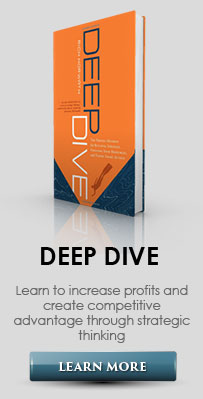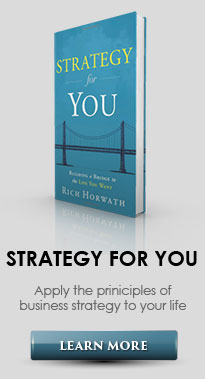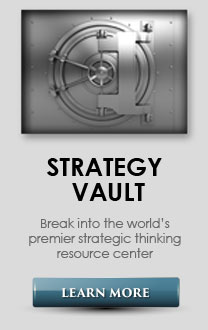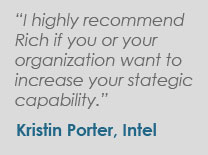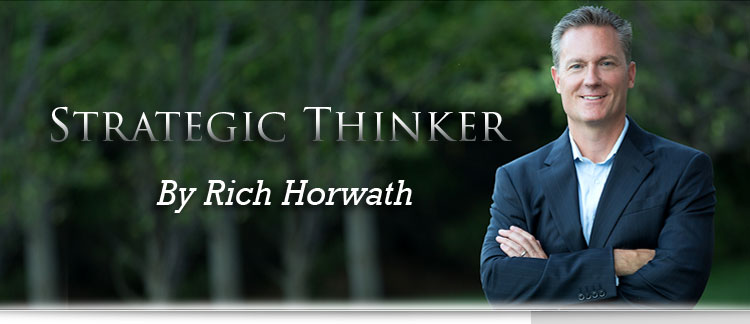
Your Toughest Competitor: YouWhen we think about competition, in sports we point to the team on the opposing bench. In politics, we point to the group with the opposing policy views. In business, we point to the company with the opposing products or services. But, what if your most dangerous business competitor wasn't across town, online, or a global behemoth? What if it was you? Research by Bain & Company on the factors that cause companies to miss their financial goals found that 90 percent of the time, the primary causes were internal. Surveys with more than four-hundred executives across fifty-six companies found that 94 percent of executives in large companies identified internal issues as the key barrier to profitable growth. In my work facilitating strategic thinking and planning sessions with companies around the world, I have heard a variety of internal challenges described by managers at all levels. Let's review five internal competitors and techniques for overcoming them. 1. Complexity. As an organization grows, layers of process, systems, products, services and people grow to support it. However, if the growth in these areas isn't approached in a thoughtful way, the organization begins to look like the tree that never gets pruned. The unmanaged complexity becomes the root cause of slowing down the decision-making processes, wasting resources on projects that aren't adding real value and fogging up the strategic direction. If you've missed opportunities because of slow decision making, or are not crystal clear on the company's mission, vision, goals, objectives and strategies, complexity may be clouding your view. 2. Silos. While silos have proven to be helpful in containing and protecting valued materials such as grain or coal, in business they can fracture a company's success by cutting off people and their ideas from one another. Silos can be just as prevalent in small companies with dozens of people as they are in global enterprises with tens of thousands of people. Silos can be intentionally constructed to protect budgets and power bases or unintentionally developed as groups operate without a keen awareness of what their colleagues in other functional areas are doing. If you don't understand how your work meshes with the work of your colleagues in other departments or levels, then silos may be rising. 3. No priorities. One of the great sources of frustration in business is working for a leader where everything—and consequently nothing—is a priority. Working on too many initiatives or tasks without clear priorities submerges people's will to the point where they are frantically trying to keep their heads above water. A leader that does not establish clear priorities for his or her team isn't a leader at all—they're an order taker at a fast-food drive-through window. Instagram co-founder Kevin Systrom said, "Most companies that serve half a billion people have thousands of people. We're still in the hundreds, so we have to focus. It's prioritizing that makes us efficient and makes us succeed." If you can't identify the businesses top three priorities, when another non-prioritized request comes in, ask if they'd like fries with that. 4. Risk aversion. Human nature demonstrates that we have an affinity for the status quo. While change may be good and even necessary in certain circumstances, it takes effort and discipline to escape the pull of the safe or familiar route. Research out of Harvard University has shown that up to 80 percent of adults said that the task of "thinking differently" is exhausting and uncomfortable. However, if the aversion to risk and doing things differently is left unchecked, it can cause us to miss taking advantage of some game-changing opportunities. When Amazon.com CEO Jeff Bezos was asked, "What would you say has been the nature of your biggest strategic mistakes?" he replied, "I think most big errors are errors of omission rather than errors of commission. They are the ones that companies never get held to account for—the times when they were in a position to notice something and act on it, had the skills and competencies or could have acquired them, and yet failed to do so." If you continually allow promising new opportunities to go by because they all seem too risky, then a culture of risk aversion is being cemented. 5. Fire drills. Fire drills are events where urgent, but unimportant matters, receive an undue amount of resources—attention, time, people, and budget—to resolve them. While they may seem like exciting and adrenaline-inducing activities, they should not be confused with real work. In some companies, managers who react and respond to fire drills quickly are viewed as go-getters, when in fact, the only thing they should be getting is your coffee. As Henry David Thoreau wrote, "It's not enough to be busy, so are the ants. The question is, what are we busy about?" If you work in an environment where urgent but unimportant events receive immediate resources, you're going to need a bigger hose. To help eliminate these internal competitors, consider using the following techniques: Strategy Conversations. If your meetings and teleconferences continually devolve into reactionary fire drills and the same discussions about the same tactics, it's time to add a little structure. I've found the most effective managers are the ones who dedicate separate meetings or blocks of time to strategy, operations, budgets and tactical activities. Fail to keep these separate and the discussion will lunge to tactics in the first five minutes. Make these strategy conversations productive by ensuring each meeting or teleconference meets three criteria: intent (goals for the interaction); decisions (items to move forward); and insights (identifying the key learnings). Decision Rights. A simple method of eliminating several internal competitors is to assign decision rights for specific initiatives, projects, events or processes. Too often, opportunities are missed and complexity results in confusion because it's not clear who owns the decision. There are a host of frameworks including RACI (Responsible, Accountable, Consulted, Informed), RAPID (Recommend, Agree, Perform, Input, Decide), etc. that help clarify the various roles that ensure decisions are being made and acted upon. I've found that visually mapping the events or processes that are causing bottlenecks and then overlaying the different roles, including who has decision rights, is a powerful tool for change. Trade Offs. It's one thing to know that great strategy is as much about what you choose not to do as it is about what you choose to do. It's another to have the courage to make those trade-offs. Strategy inherently involves risk because by making a trade-off, you are intentionally saying no to certain internal and even external customers to focus your value. Develop your priorities by focusing on those items that are most essential to helping you achieve your goals and strategies. Then prune the extraneous activities and tasks that are not instrumental in helping you achieve your goals. It's comfortable to make an external competitor the bad guy, the one keeping us from turning a profit or being successful. And in some cases, the external competitor is changing the value equation in the market and they are a legitimate obstacle to overcome. But in many cases, the real issues are staring us in the face on a daily basis, because they are internal. Look in the mirror. What do you see? |


